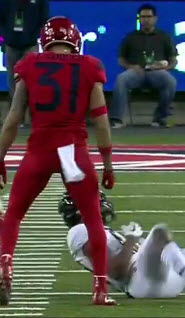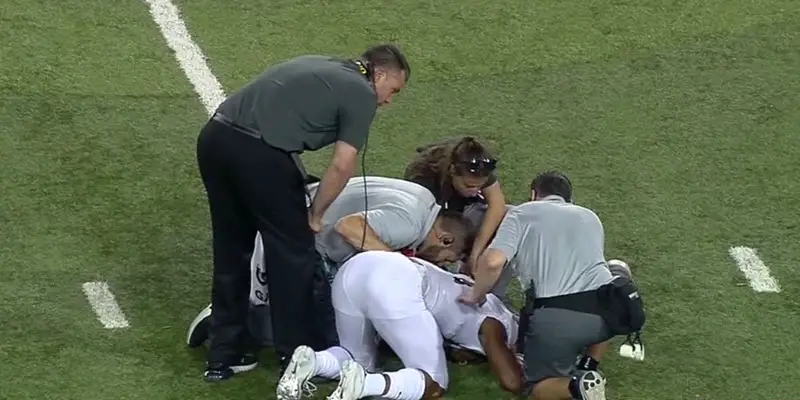My friends–we have progressed as a site because such an amazing group of Oregon fans who have turned the comments below articles into a “high-brow” discussion of Oregon sports that will always be “TROLL-FREE.”
I am always interested in a short article to start a discussion, a “Ponder-Point” if you will, and a reader brought us a tremendous topic for us to consider. If you have a topic–email it to me and we’ll publish it. And do support a fellow reader and give us your thoughts on this very important subject below. Charles Fischer
——————————————————————————————————————
An athlete at full speed crashes into the chest of his opponent who then falls to the ground, motionless. This is what we witnessed in the Arizona game as Wildcat safety Tristan Cooper unloaded a vicious hit to an unprotected and unwary Dillon Mitchell. After the game, Mitchell was placed into “concussion protocol” and held from practice: the whiplash effect upon his brain an obvious and serious concern.

Tristan Cooper looms over Dillon Mitchell.
Cooper, who in the heat of the moment stood above the fallen Mitchell in a taunting pose as a fellow teammate of Cooper’s launched himself into the air in celebration, commented later that he was looking to “take him out,” and further, that he was sorry he couldn’t have speared him with his helmet. He then added that as a high school student he had seen an Arizona safety deliver a similar hit, though in that one he thought the player “had died,” and that it was a “better hit than mine.” That hit, he clarified, was an inducement to attend Arizona.
Football is not a contact sport — that would be basketball, or soccer. American football is a collision sport, like hockey or rugby. Violence and intimidation are part of the game and part of its appeal. The application of pain, its accumulation, and its threat are central to it. But at some point, and I think it’s a clear one, inflicting pain crosses over to seeking to injure — and that’s dangerous to both participant and observer.
Let’s make one thing clear, there is a difference between playing the sport and watching it. The player is engaging in a sport, the fan is being entertained … nothing more. Do we wish to continue to encourage ultra-violence to feed our ever greater need to be amused?
The situation now is quite different from a few years ago: we all now know about the devastating, permanent brain injuries that occur. It isn’t necessary to strike with the helmet — shoulder hits at-or-above the shoulders can cause severe whiplash and loss of consciousness with potential permanent injury. We already know that the damage from such blows is cumulative, haunting players long after the stadium cheers have faded away.
So, what would happen if such dangerous hits, helmet or not, were outlawed? Even were there an increase in crossing routes, wouldn’t that be positive? I’d certainly enjoy more scoring.
Hockey and rugby are not known as sissy sports, yet they do much more to protect the players. Football can protect its players without hollowing out what is the greatest team sport known to man. It will do so voluntarily or by necessity: nationwide, participation by youngsters and young men is plummeting.
To those who object to toning down head-directed violence, I ask two questions: would you like your son to have been in Dillon Mitchell’s shoes at 6:52 of the third quarter in the Arizona game? Would you have celebrated and been proud had Tristan Cooper been your son?
Jayme Vasconcellos
Eugene, Oregon
Top Photo From Video
Related Articles:
Oregon Enters Playoffs Better Off Than Last Year
Will The Coaching Carousel Kill Oregon's CFP Chances?
The Playoff Formula Hasn't Changed
Oregon Aims to Bury Dawgs, Punch Playoff Ticket in Rivalry Clash
Huskies Are the New Beavers, Stay In Your Lane Kiffin, and the Civil Apple Cup War
Oregon Football: The X-Factor Vs. Washington
Jayme Vasconcellos has been a football fanatic since his father took him to his first game, the Minnesota Vikings inaugural regular season opener against the Bears (9/17/’61) in freezing cold Bloomington Stadium (the Vikings won!). Fran Tarkenton, Hugh McElhenny, and Tommy Mason starred for Coach (and former Duck) Norm van Brocklin in his first job after retiring as a star NFL quarterback

